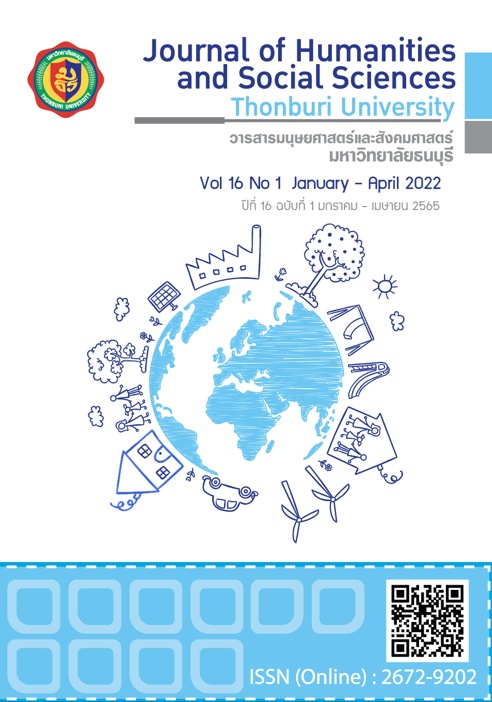สมดุลสุขภาพกับการทำงาน ของข้าราชการครูและบุคลากรทางการศึกษากรุงเทพมหานคร
Main Article Content
บทคัดย่อ
การวิจัยครั้งนี้มีวัตถุประสงค์เพื่อศึกษาสมดุลสุขภาพกับการทำงาน ปัจจัยเชิงสาเหตุและผลของสมดุลสุขภาพกับการทำงานของข้าราชการครูและบุคลากรทางการศึกษากรุงเทพมหานคร ใช้ระเบียบวิธีวิจัยเชิงคุณภาพ ด้วยเทคนิคการสัมภาษณ์เชิงลึกแบบกึ่งโครงสร้าง โดยการเลือกกลุ่มผู้ให้ข้อมูลแบบเจาะจง ได้แก่ ข้าราชการครูและบุคลากรทางการศึกษากรุงเทพมหานครที่สอนในโรงเรียนขนาดใหญ่พิเศษ จำนวน 12 คน เครื่องมือที่ใช้ในการวิจัยได้แก่ แบบสัมภาษณ์เชิงลึกเกี่ยวกับสมดุลสุขภาพกับการทำงาน ซึ่งตรวจสอบความเหมาะสมและความครบถ้วนสมบูรณ์ของเครื่องมือโดยผู้เชี่ยวชาญ สำหรับวิธีการวิเคราะห์ข้อมูลใช้การสรุปเชิงเนื้อหาและวิเคราะห์ความน่าเชื่อถือของข้อมูลด้วยเทคนิคสามเส้าด้านข้อมูล ผลการวิจัยพบว่า สมดุลสุขภาพกับการทำงานของข้าราชการครูและบุคลากรทางการศึกษากรุงเทพมหานครคือ สภาวะที่ครูและบุคลากรทางการศึกษารู้สึกว่าสามารถรักษาสมดุลระหว่างสุขภาพและความต้องการในการทำงานได้อย่างมีประสิทธิภาพ ซึ่งประกอบไปด้วย ความไม่สมดุลกันระหว่างการทำงานและสุขภาพ การสนับสนุนจากภายนอกและบรรยากาศด้านสุขภาพ สำหรับปัจจัยเชิงสาเหตุของสมดุลสุขภาพกับการทำงาน ได้แก่ 1) การมาทำงานขณะเจ็บป่วย 2) การสนับสนุนจากเพื่อนร่วมงาน 3) การมีจิตสำนึกด้านสุขภาพ และพบว่าผลของการขาดสมดุลสุขภาพกับการทำงานได้แก่ ความเครียด
Article Details
References
ประชาชาติธุรกิจ. (8 มิถุนายน 2563). กทม.จัดระเบียบร.ร.ขนาดเล็กเปิดปกติ “ขนาดกลาง-ใหญ่” สลับวันเรียนจำกัดห้องละ 20 คน. สืบค้นเมื่อ 5 เมษายน 2564, จาก https://www.prachachat.net/education/news-474691
ปิยะฉัตร นาคประสงค์. (2550). ผลของโปรแกรมการใช้อารมณ์ขันเพื่อลดความเครียดของวัยรุ่น. วิทยานิพนธ์ปริญญามหาบัณฑิต. กรุงเทพมหานคร. มหาวิทยาลัยศรีนครินทรวิโรฒ. จาก http://thesis.swu.ac.th/swuthesis/Gui_ Cou_Psy/Piyachut_N.pdf.
สำนักการศึกษา. กรุงเทพมหานคร. (2563). สถิตินักเรียน-ห้องเรียน-ครู 2563 (Excel). สืบค้นเมื่อ 24 มีนาคม 2564, จาก http://www.bangkok.go.th/Bangkokeducation/page/sub/20731/
สำนักงานกองทุนสนับสนุนการสร้างเสริมสุขภาพ. (2557). การออกกำลังกายที่มีประสิทธิภาพ. สืบค้นเมื่อ 5 เมษายน 2564, จาก https://www.thaihealth.or.th/Content/250289E.html
สำนักงานส่งเสริมสวัสดิการและสวัสดิภาพครูและบุคลากรทางการศึกษา. (2563). แผนปฏิบัติราชการระยะ 3 ปี (พ.ศ.2563-2565). สืบค้นเมื่อ 22 เมษายน 2564. จาก http://www.otep.go.th/admin/assets/upload/files/o4-plan_L3. pdf
สุพรรณี ไชยอำพร. (2552). การวิจัยเชิงคุณภาพ แนวความคิด วิธีการ และการประยุกต์ใช้. กรุงเทพฯ: วิทยาลัยเทคนิคมีนบุรี.
สุภางค์ จันทวานิช. (2553). วิธีการวิจัยเชิงคุณภาพ. พิมพ์ครั้งที่ 18. กรุงเทพฯ: สำนักพิมพ์แห่งจุฬาลงกรณ์มหาวิทยาลัย.
Baptista, N., Alves, H., & Pinho, J. C. (2020a). Uncovering the use of the social support concept in social
Carmichael, G. S. (2015). The Research Is Clear: Long Hours Backfire for People and for Companies. Retrieved 24 April 2021. From https://hbr.org/2015/08/the-research-is-clear-long-hours-backfire-for-people-and-for-companies.
Crout, L. A., Chang, E. and Cioffi, J. (2005). Why Do Registered Nurses Work When Ill?. Journal of Nursing Administration. 35(1), 23-28. doi: 10.1097/00005110-200501000-00010
Deery, M. and Jago, L. (2015). Revisiting talent management, work-life balance and retention strategies. International Journal of Contemporary Hospitality Management. 27(3): 453-472. doi: 10.3389/fpsyg.2020.597624doi: https://doi.org/10.1080/10495142.2020.1760999
Giauque, D., Anderfuhren-Biget, S. and Varone, F. (2019). Stress and turnover intents in international organizations: social support and work–life balance as resources. The International Journal of Human Resource Management. 30(5): 879-901. doi: 10.1080/09585192.2016.1254105
Gould, S. J. (1988). Consumer attitudes toward health and health care: A differential perspective. Journal of Consumer Affairs. 22(1): 96-118. doi: 10.1111/j.1745-6606.1988.tb00215.x
Gragnano, A., Miglioretti, M., Frings-Dresen, M. H. W., and de Boer, A. G. E. M. (2017). Adjustment Between Work Demands and Health Needs: Development of the Work–Health Balance Questionnaire. Rehabilitation Psychology. 62(3): 374–386. From https://doi.org/10.1037/rep0000121
Gragnano, A., Miglioretti, M., Simbula, S., and de Boer, A. (2015). Work-Health Balance - A new construct to explain workers’ well being after RTW. Poster session presented at Conference: XVII Conference of the European Association of Work and Organizational Psychology (EAWOP), Oslo, Norway.
Hafeez, U. and Akbar, W. (2014). Impact of work-life balance on job satisfaction among school teachers of 21st century. Australian Journal of Business and Management Research New South Wales Research Centre Australia (NSWRCA). 4(11), 25-37. From https://www.researchgate.net/publication/289915954
Hoque, M. Z., Alam, N. and Nahid, K. A. (2018). Health Consciousness and Its Effect on Perceived Knowledge, and Belief in the Purchase Intent of Liquid Milk: Consumer Insights from an Emerging Market. Foods. Journal of foods. 7(9): 150. From https://doi.org/10.3390/foods7090150
Lazarus, R.S. and Folkman, S. (1984). Stress appraisal, and coping. New York: Springer Publishing.
Malecki, C. K. and Kilpatrick, M. (2003). What Type of Support Do They Need? Investigating marketing interventions for health. Journal of Nonprofit and Public Sector Marketing.
Mastroiannia, K. and Storberg-Walker, J. (2014). Do work relationships matter? Characteristics of workplace interactions that enhance or detract from employee perceptions of well-being and health behaviors. Health Psychology & Behavioral Medicine. 2(1): 798–819, doi: 10.1080/21642850.2014.933343
Nuriye Çelmeçe and Mustafa Meneka. (2020). The Effect of Stress, Anxiety and Burnout Levels of Healthcare
Professionals Caring for COVID-19 Patients on Their Quality of Life. Front.Psychol. 11:597624,
Ramsey, R. D. (2006). “Presenteeism” a new problem in the workplace. Supervision: the journal of industrial relations and operating management. 67(8): 14–17.
Student Adjustment as Related to Emotional, Informational, Appraisal, and Instrumental Support. School Psychology Quarterly. 18(3): 231–252. From https://doi.org/10.1521/scpq.18.3.231.22576
Sultan, T. and Nag, N. (2020). Work-Health Balance: Characterizing Short-Term and Long-Term Impact to Health. Retrieved 24 April 2021. From https://ideas.repec.org/p/osf/mindrx/5rmp8.html
Xue Y., Liu G., Feng Y., Xu, M., Jiang, L., Lin, Y. and Xu, J. (2020). Mediating effect of health consciousness in the relationship of lifestyle and suboptimal health status: a cross-sectional study involving Chinese urban residents. BMJ Journal. 10, 1-8. From https://bmjopen.bmj.com/content/bmjopen/10/10/e039701.full.pdf
Zhou, J., and George, J. M. (2001). When job dissatisfaction leads to creativity: Encouraging the expression of voice. Academy of Management journal, 44(4), 682-696. From https://www.jstor.org/stable/pdf/3069410.pdf
Translated Thai References
Chaiamporn, S. (2009). Qualitative Research, Concepts, Methods and Applies. Bangkok: Minburi Technical College. (in Thai)
Chantavanich, S. (2010). Qualitative research methods. 18thed. Bangkok : Chulalongkorn University Press. (in Thai)
Department of Education, Bangkok. (2020). Statistics of Student - Classroom - Teacher 2020 (Excel). Retrieved March 24, 2021, from http://www.bangkok.go.th/bangkokeducation/page/sub/20731/. (in Thai)
Narkpasong, P. (2007). The Effects of Sense of Humor Encouraging Program to Reduce Tension of Teenagers. Master Thesis in Education, Srinakharinwirot University. (in Thai)
Office of the Welfare Promotion Commission for Teachers and Educational Personnel. (2020). 3-year government action plan (2020-2022). Retrieved April 22, 2021. From http://www.otep.go.th/admin/assets/upload/files/o4-plan_ L3.pdf. (in Thai)
Prachachat Online. (June 8, 2020). BMA organizes small schools to open normally "medium-large" to switch classes, limited to 20 students per room. From https://www.prachachat.net/education/news-474691. (in Thai)
Thai Health Promotion Foundation Online. (July 10, 2014). Effective exercise. Retrieved April 5, 2021. From https://www.thaihealth.or.th/Content/250289E.html. (in Thai)

